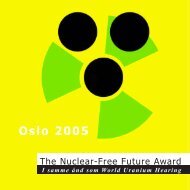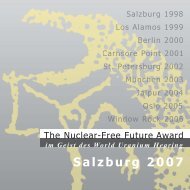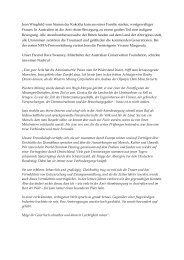New York City - The Nuclear-Free Future Award
New York City - The Nuclear-Free Future Award
New York City - The Nuclear-Free Future Award
Create successful ePaper yourself
Turn your PDF publications into a flip-book with our unique Google optimized e-Paper software.
When Bruno Barrillot received the news that he would be one of<br />
this year’s <strong>Nuclear</strong>-<strong>Free</strong> <strong>Future</strong> <strong>Award</strong> laureates, he reacted in<br />
customary fashion: modest, self-effacing, puzzled by the jury’s<br />
selection. His decades of work and activism were a matter of<br />
course, nothing exemplary. Barrillot turned seventy this past<br />
spring, a white-haired, thin Frenchman of diminutive height<br />
with the spirited, intelligent gaze of a rebel. Few of Barrillot’s<br />
countrymen know who he is – the ‚Little Priest’ (his nickname)<br />
prefers to influence the course of affairs from behind the scenes,<br />
stepping only into the spotlight as a messenger of the outcomes<br />
he advocates. Were it not for Barrillot’s years of activism<br />
and brilliant lobbying<br />
efforts in Paris, the<br />
recent French law to<br />
compensate victims<br />
of nuclear testing would almost certainly never have become<br />
a reality.<br />
Indigenous peoples of the Pacific were the frontline victims<br />
of nuclear weapons testing by France, Britain and the<br />
United States. <strong>The</strong> lonely atolls of the central and south Pacific<br />
were considered ‚empty’ spaces perfect for optimizing nuclear<br />
payloads. A French Defense Ministry report says France conducted<br />
46 atmospheric nuclear tests from 1966-1974 and 147<br />
underground nuclear tests from 1975-1996, with most of the<br />
testing occurring at Mururoa. As recently as 2003, then-President<br />
Jacques Chirac told a Tahitian newspaper Les Nouvelles de<br />
Tahiti that the atomic tests had “no effect on health”. Against<br />
a backdrop of island protest – Tahiti lies some 750 nautical<br />
miles southeast of Mururoa – Chirac said: “<strong>The</strong>re are no health<br />
consequences, either in the short-term or long-term.<br />
With the French nuclear testing compensation law, one of<br />
Bruno Barrillot’s long-lived dreams became reality: the legislation<br />
amounts to a confession of guilt – La Grande Nation’s<br />
nuclear warhead testing program had indeed endangered the<br />
health and lives of the nearly 150,000 people living in the<br />
Pacific region. <strong>The</strong> French legislation recanted decades of disinformation<br />
and whitewash.<br />
Bruno Barrillot’s course in life was changed radically in<br />
July of 1985 by the Rainbow Warrior affair. French foreign<br />
intelligence services sabotaged the Greenpeace flagship in the<br />
<strong>New</strong> Zealand harbor of Auckland in order to prevent the vessel<br />
from undertaking a protest voyage to Mururoa. Two explosions<br />
Solutions<br />
10<br />
sunk the ship; after the first underwater mine went off, a Dutch<br />
photographer, Fernando Pereira, raced aboard to salvage his<br />
equipment. <strong>The</strong> second charge sent the Rainbow Warrior to the<br />
bottom, drowning Pereira.<br />
Two French agents arrested by the <strong>New</strong> Zealand police on<br />
passport fraud and immigration charges later pleaded guilty to<br />
sinking the ship and committing manslaughter. Angered, his<br />
trust in the government badly shaken, Barrillot, together<br />
with Jean-Luck Thierry, nuclear expert of Greenpeace France,<br />
and Patrice Bouveret, quickly founded the “Center for Documentation<br />
and Research on Peace and Conflict” (CDRPC).<br />
<strong>The</strong> mission of the organization, Barrillot tells us, is “to open<br />
the public to alternatives to the atom by facilitating access to<br />
concrete information conveying the attendant risks to health<br />
and the environment.” Headquartered in Lyon, CDRPC has<br />
developed a reputation as an expert independent research institution<br />
on issues of nuclear policy and national security.<br />
Earlier in life Bruno Barrillot had worked as a Priest<br />
specializing in helping conscientious objectors negotiate the<br />
French legal system. But when French bishops issued a collective<br />
statement characterizing the government’s policy of<br />
nuclear deterrence as “acceptable”, Barrillot left the church to<br />
begin life anew as a Lyon journalist writing for the leftist publication<br />
Libération. He was in his late forties.<br />
On June 13, 1995, after Mr. Chirac incited global protests<br />
by announcing that he would break a three-year moratorium<br />
and resume nuclear testing, Barrillot’s journalistic focus<br />
shifted towards investigating the living conditions of French<br />
Polynesians. During his many expeditions to the islands of the<br />
region, Barrillot assembled dossiers of personal interviews, weaving<br />
many accounts into his CDRPR reports. One could say that<br />
Barrillot’s research jump-started two victims of nuclear testing<br />
organizations: in Papeete, Tahiti, Association Moruroa e tatou,<br />
and in Lyon, Association de veterans des essais nucléaires.<br />
Bruno Barrillot was the Director of CDRPR until 2005.<br />
Since then he has worked throughout Polynesia on behalf of<br />
regional goverments to help uncover the true legacy of nuclear<br />
testing. Presently, in collaboration with an international network<br />
of experts, Barrillot is performing lobbyist actions in a<br />
fresh direction: to come up with a set of international standards<br />
to parse the real consequences of nuclear weapons testing. <strong>The</strong><br />
'Little Priest' entertains no thought of retirement.





